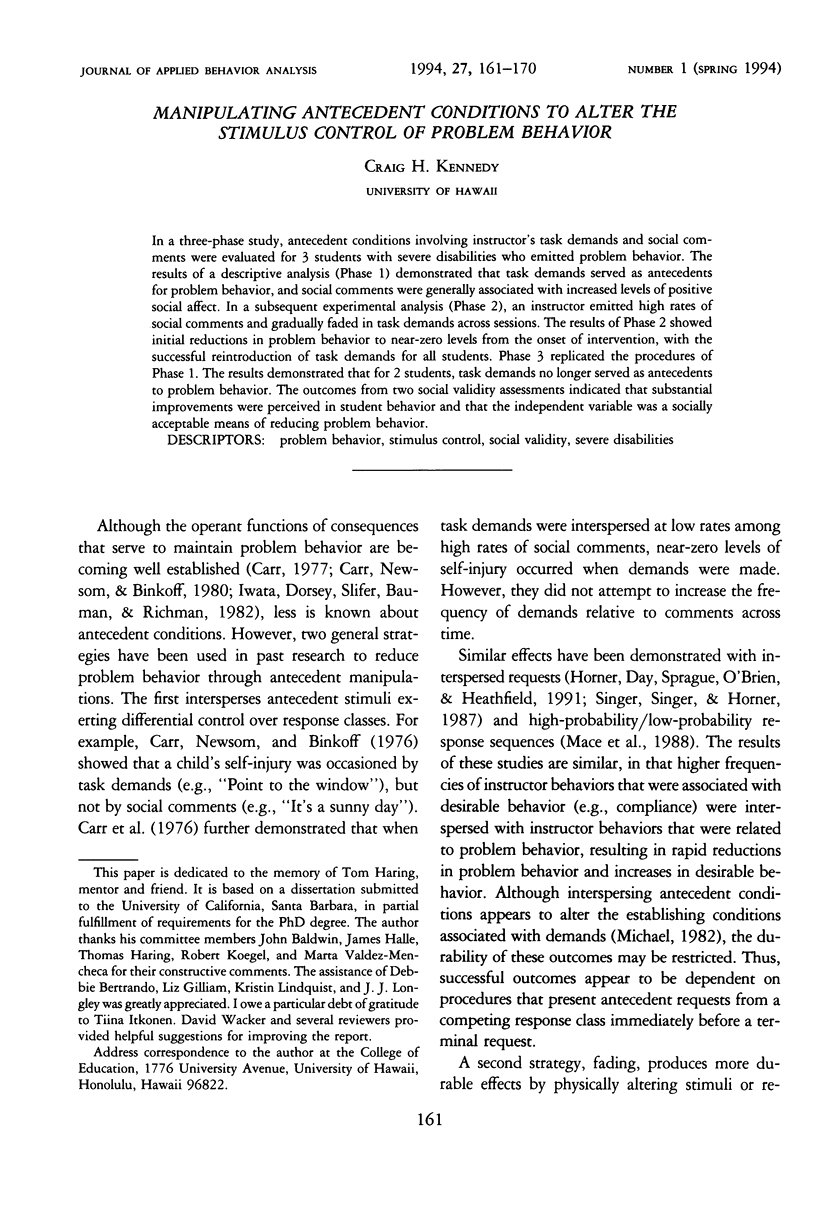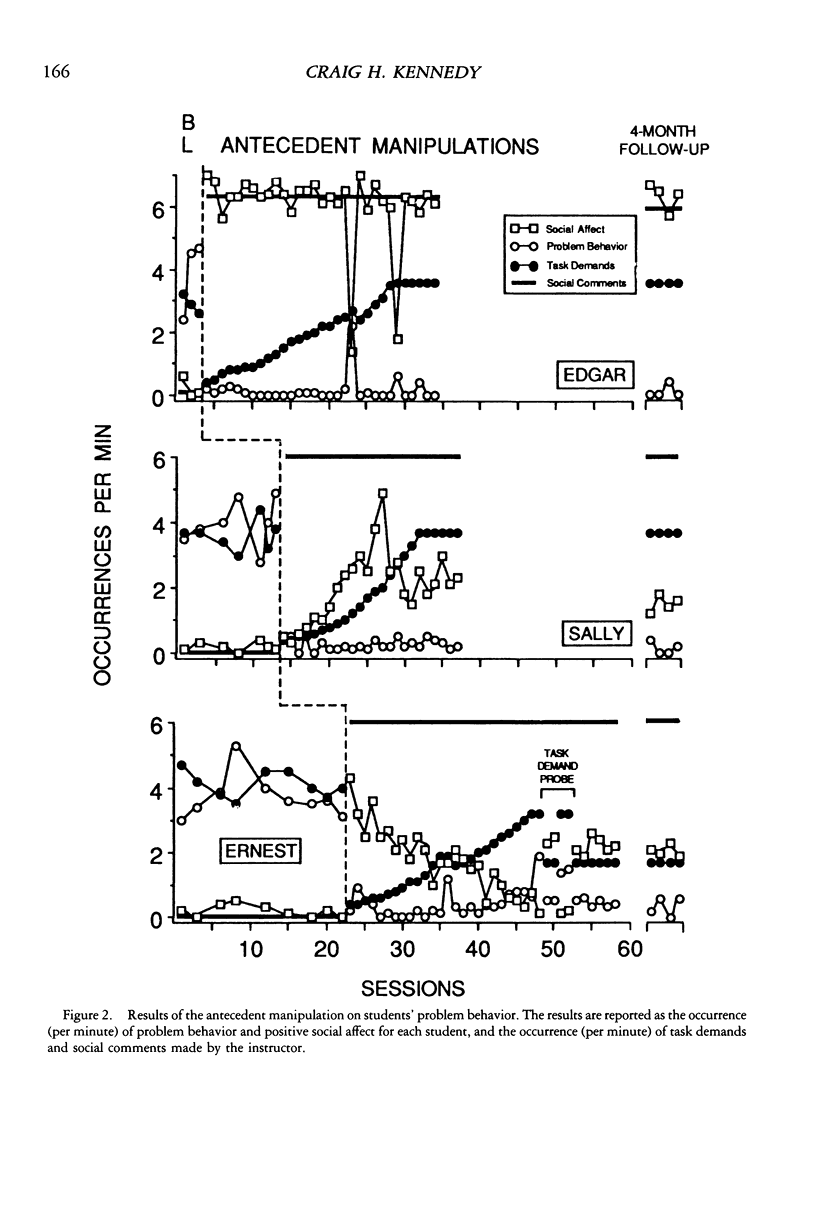Abstract
In a three-phase study, antecedent conditions involving instructor's task demands and social comments were evaluated for 3 students with severe disabilities who emitted problem behavior. The results of a descriptive analysis (Phase 1) demonstrated that task demands served as antecedents for problem behavior, and social comments were generally associated with increased levels of positive social affect. In a subsequent experimental analysis (Phase 2), an instructor emitted high rates of social comments and gradually faded in task demands across sessions. The results of Phase 2 showed initial reductions in problem behavior to near-zero levels from the onset of intervention, with the successful reintroduction of task demands for all students. Phase 3 replicated the procedures of Phase 1. The results demonstrated that for 2 students, task demands no longer served as antecedents to problem behavior. The outcomes from two social validity assessments indicated that substantial improvements were perceived in student behavior and that the independent variable was a socially acceptable means of reducing problem behavior.
Full text
PDF









Selected References
These references are in PubMed. This may not be the complete list of references from this article.
- Carr E. G., Newsom C. D., Binkoff J. A. Escape as a factor in the aggressive behavior of two retarded children. J Appl Behav Anal. 1980 Spring;13(1):101–117. doi: 10.1901/jaba.1980.13-101. [DOI] [PMC free article] [PubMed] [Google Scholar]
- Carr E. G., Newsom C. D., Binkoff J. A. Stimulus control of self-destructive behavior in a psychotic child. J Abnorm Child Psychol. 1976;4(2):139–153. doi: 10.1007/BF00916518. [DOI] [PubMed] [Google Scholar]
- Carr E. G. The motivation of self-injurious behavior: a review of some hypotheses. Psychol Bull. 1977 Jul;84(4):800–816. [PubMed] [Google Scholar]
- Dunlap G., Koegel R. L. Motivating autistic children through stimulus variation. J Appl Behav Anal. 1980 Winter;13(4):619–627. doi: 10.1901/jaba.1980.13-619. [DOI] [PMC free article] [PubMed] [Google Scholar]
- Heidorn S. D., Jensen C. C. Generalization and maintenance of the reduction of self-injurious behavior maintained by two types of reinforcement. Behav Res Ther. 1984;22(5):581–586. doi: 10.1016/0005-7967(84)90062-7. [DOI] [PubMed] [Google Scholar]
- Horner R. H., Day H. M., Sprague J. R., O'Brien M., Heathfield L. T. Interspersed requests: a nonaversive procedure for reducing aggression and self-injury during instruction. J Appl Behav Anal. 1991 Summer;24(2):265–278. doi: 10.1901/jaba.1991.24-265. [DOI] [PMC free article] [PubMed] [Google Scholar]
- Iwata B. A., Pace G. M., Kalsher M. J., Cowdery G. E., Cataldo M. F. Experimental analysis and extinction of self-injurious escape behavior. J Appl Behav Anal. 1990 Spring;23(1):11–27. doi: 10.1901/jaba.1990.23-11. [DOI] [PMC free article] [PubMed] [Google Scholar]
- Kazdin A. E. Acceptability of alternative treatments for deviant child behavior. J Appl Behav Anal. 1980 Summer;13(2):259–273. doi: 10.1901/jaba.1980.13-259. [DOI] [PMC free article] [PubMed] [Google Scholar]
- Koegel R. L., Egel A. L. Motivating autistic children. J Abnorm Psychol. 1979 Aug;88(4):418–426. doi: 10.1037//0021-843x.88.4.418. [DOI] [PubMed] [Google Scholar]
- Mace F. C., Hock M. L., Lalli J. S., West B. J., Belfiore P., Pinter E., Brown D. K. Behavioral momentum in the treatment of noncompliance. J Appl Behav Anal. 1988 Summer;21(2):123–141. doi: 10.1901/jaba.1988.21-123. [DOI] [PMC free article] [PubMed] [Google Scholar]
- Michael J. Distinguishing between discriminative and motivational functions of stimuli. J Exp Anal Behav. 1982 Jan;37(1):149–155. doi: 10.1901/jeab.1982.37-149. [DOI] [PMC free article] [PubMed] [Google Scholar]
- Pace G. M., Iwata B. A., Cowdery G. E., Andree P. J., McIntyre T. Stimulus (instructional) fading during extinction of self-injurious escape behavior. J Appl Behav Anal. 1993 Summer;26(2):205–212. doi: 10.1901/jaba.1993.26-205. [DOI] [PMC free article] [PubMed] [Google Scholar]
- Parrish J. M., Cataldo M. F., Kolko D. J., Neef N. A., Egel A. L. Experimental analysis of response covariation among compliant and inappropriate behaviors. J Appl Behav Anal. 1986 Fall;19(3):241–254. doi: 10.1901/jaba.1986.19-241. [DOI] [PMC free article] [PubMed] [Google Scholar]
- Touchette P. E., MacDonald R. F., Langer S. N. A scatter plot for identifying stimulus control of problem behavior. J Appl Behav Anal. 1985 Winter;18(4):343–351. doi: 10.1901/jaba.1985.18-343. [DOI] [PMC free article] [PubMed] [Google Scholar]
- Weeks M., Gaylord-Ross R. Task difficulty and aberrant behavior in severely handicapped students. J Appl Behav Anal. 1981 Winter;14(4):449–463. doi: 10.1901/jaba.1981.14-449. [DOI] [PMC free article] [PubMed] [Google Scholar]


